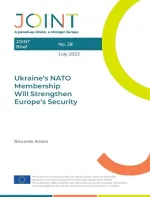Ukraine’s NATO Membership Will Strengthen Europe’s Security

JOINT Brief nº 28 (July 2023)
NATO’s refusal to set a clear pathway for Ukraine’s membership largely dominated the expert and public debate over the Alliance’s summit in Vilnius last week.1 It also overshadowed its significant, even historic, results.2
After all, in Vilnius, NATO all but acquired a new member (barring surprises from Turkey’s parliament): not (yet) Ukraine but Sweden. Coming on the heels of Finland’s, Sweden’s accession solidifies NATO’s dominating position in the Baltic basin,3 which in recent years has been the theatre of much of Russia’s destabilising activism,4 ranging from continual provocations and intimidation by Russian navy and air forces to sabotage (for instance, of undersea cables5 and perhaps pipelines6 too).
Sweden got the green light after Turkey (soon followed by the other holdout Hungary) lifted its veto. While there was no official confirmation, it is an open secret that the negotiation was unlocked by US President Joe Biden’s promise to allow the sale of F-16 fighter jets to Ankara.7 Five years after the ill-conceived decision to acquire the S-400 air defence system from Russia, which had prompted the United States to downgrade bilateral military cooperation, Turkey has thus made another step bringing it closer to its historical NATO allies.8 NATO leaders also endorsed new plans to bolster the Alliance’s defence and deterrence capabilities, which now involve greater (and arguably permanent) deployment of military assets to countries closer to Russia’s borders, and agreed on more ambitious defence spending and investment schemes.9
So all good bar Ukraine? On the contrary, the summit has delivered – and considerably so – also on that front. Most importantly, it has made it clear that Ukraine’s future is in the Alliance, a hard but strategically necessary decision.
Notes:
1- NATO, Vilnius Summit Communiqué, 11 July 2023, https://www.nato.int/cps/en/natohq/official_ texts_217320.htm.
2- Steven Erlanger, “Despite Successes at NATO Summit, Divisions Remain”, in The New York Times, 12 July 2023, https://www.nytimes.com/2023/07/12/world/europe/nato-summit-ukraine-biden.html.
3- Laura Kayali, “Sorry Russia, the Baltic Sea Is NATO’s Lake Now”, in Politico, 13 July 2023, https:// www.politico.eu/?p=3330753.
4- Göran Swistek and Michael Paul, “Geopolitics in the Baltic Sea Region”, in SWP Comments, No. 2023/C 09 (February 2023), https://doi.org/10.18449/2023C09.
5- Warsaw Institute, “Russia Cripples NATO’s Undersea Communications”, in Russia Monitor, 17 January 2022, https://warsawinstitute.org/?p=55763.
6- Nicolas Camut, “Russian Ship Spotted Near Nord Stream Pipelines Days Before Sabotage: Reports”, in Politico, 28 April 2023, https://www.politico.eu/?p=2979735
7- Felicia Schwartz and Henry Foy, “US Says It ‘Intends to Move Forward’ with Transfer of F-16 Jets to Turkey”, in Financial Times, 11 July 2023, https://www.ft.com/content/cd8e7cc1-30c8-4b53-a605- 8524d5815156.
8- International Institute for Strategic Studies, “Turkey, the S-400 and the F-35”, in Strategic Comments, Vol. 25, No. 22 (August 2019), https://www.iiss.org/publications/strategic-comments/2019/ turkey-the-s400-and-the-f35; Huseyin Hayatsever, Can Sezer and Burcu Karakas, “Turkey Sets New Western Tilt in Foreign Policy as Economy Weighs”, in Reuters, 11 July 2023, http://reut.rs/3O7kSVg
9- NATO, NATO Agrees Strong Package for Ukraine, Boosts Deterrence and Defence, 11 July 2023, https://www.nato.int/cps/en/natohq/news_217059.htm.